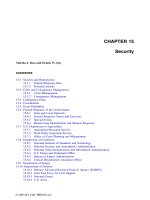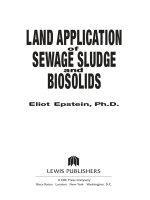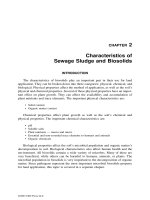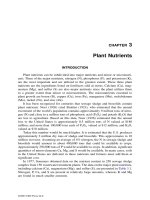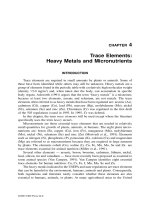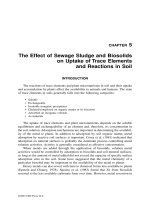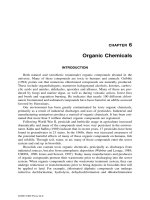Phytoremediation of Contaminated Soil and Water - Chapter 15 potx
Bạn đang xem bản rút gọn của tài liệu. Xem và tải ngay bản đầy đủ của tài liệu tại đây (504.46 KB, 17 trang )
15
The Role of Bacteria in the
Phytoremediation of
Heavy Metals
D. van der Lelie, P. Corbisier, L. Diels, A. Gilis,
C. Lodewyckx, M. Mergeay, S. Taghavi,
N. Spelmans, and J. Vangronsveld
CONTENTS
Introduction
Effects of Siderophore Production by Rhizosphere Bacteria on Plant Growth
Interactions of Siderophores with Heavy Metals
Metal-Resistant Soil Bacteria
Bacterial Heavy Metal Resistance: The czc (Cadmium, Zinc, Cobalt) Operon
Possible Effects of Heavy Metal-Resistant Soil Bacteria on Heavy Metal Speciation
Applications of A. eutrophus CH34 Heavy Metal Resistances for the
Removal of Heavy Metals
Heavy Metal Biosensors Based on Bacterial Heavy Metal Resistance Genes
Use of Biomet Sensors to Predict Heavy Metal Phytotoxicity
Acknowledgment
References
INTRODUCTION
The metabolic capacity of plant-associated bacteria may be used to develop new
phytoremediation strategies. In the rhizosphere, many pesticides as well as trichloro-
ethylene, polycyclic aromatic compounds, and petroleum hydrocarbons are degraded
at accelerated rates (Hsu and Bartha, 1979; Nichols et al., 1997). Scientists are using
plants for phytoextraction and phytoimmobilization of heavy metals from polluted
soils and wastewater. Although plant-associated bacteria have dynamic and varied
metabolic capacities, current strategies do not capitalize on the physiology of these
microbes in phytoremediation processes. Plants stimulate the growth of microorgan-
isms due to secretion of organic molecules by their roots. This results in higher
population densities of bacteria in the rhizosphere (Anderson and Coats, 1995;
Rovira et al., 1979). In addition, endophytic bacteria colonize the interior of root
and stem tissues. In this chapter, the potential impact of soil bacteria on heavy metal
Copyright © 2000 by Taylor & Francis
extraction by plants is discussed. We have given special attention to heterologous
expression of heavy metal resistance genes by plant associated baceria. In addition,
the development of reporter gene systems to determine the level of available heavy
metals is explored, this in relation to phytotoxicity.
EFFECTS OF SIDEROPHORE PRODUCTION BY
RHIZOSPHERE BACTERIA ON PLANT GROWTH
Rhizosphere bacteria, including those which carry plasmid-borne resistances to
heavy metals, may be expected to play an important role in the bioavailability of
metals to the plant. They can produce metal-chelating agents, like siderophores, that
possess a high affinity for Fe
3+
. In oxygenated environments such as the soil, iron
is basically unavailable for uptake and limiting to microbial growth, even though it
is the fourth most abundant element in the Earth’s crust (Lindsay, 1979). Therefore,
aerobic and facultative anaerobic microorganisms have evolved various systems to
overcome the low solubility of external iron (reviewed by Neilands, 1981; Crichton
and Charloteaux-Wauters, 1987; Crosa, 1989; Guerinot, 1994).
Siderophores produced by plant growth-promoting rhizobacteria (PGPR) and
bacterial biological control agents are associated with improved plant growth, either
through a direct effect on the plant, through control of noxious organisms in the
soil, or via some other route (Kloepper et al., 1980). The PGPR include members
of the genera Arthrobacter, Alcaligenes (Ralstonia), Serratia, Pseudomonas, Rhizo-
bium, Agrobacterium, and Bacillus (O’Sullivan and O’Gara, 1992). The most prom-
ising group for application in the biocontrol of plant diseases is that of the fluorescent
pseudomonads, especially P. fluorescens and P. putida (O’Sullivan and O’Gara,
1992). Several mechanisms are known to account for the growth-promoting and
disease-suppressing impact of fluorescent siderophores on the plant. One mechanism
by which antagonists control disease is by competition for iron, mediated by fluo-
rescent siderophores, which have an extremely high affinity for ferric iron. Produc-
tion of siderophores by antagonists further limits the already limited supply of iron
in the environment (Neilands, 1981; Neilands and Leong, 1986). Growth of patho-
gens is therefore inhibited in the presence of siderophore-producing strains due to
an inadequate supply of iron.
Some plants utilize microbial ferric iron-siderophore complexes. Microbial
hydroxamate type siderophores were used by plants, such as sunflower and sorghum,
for the uptake of iron (Cline et al., 1982, 1983, 1984). Furthermore, siderophores
from fluorescent pseudomonads have also been implicated in iron uptake by tomato
(Duss et al., 1986), carnations, barley (Duijff et al., 1991), and in the reversion of
lime-induced chlorosis by peanut (Jurkevitch et al., 1988). In contrast, the fluorescent
siderophore from Pseudomonas sp. B10 inhibited iron uptake by peas and maize
plants (Becker et al., 1985).
Copyright © 2000 by Taylor & Francis
INTERACTIONS OF SIDEROPHORES WITH HEAVY
METALS
Siderophore production can be stimulated by the presence of heavy metals. Since
most siderophores also show a lower but significant affinity for bivalent heavy metal
ions, they affect the bioavailability of the heavy metals. For instance, in Azotobacter
vinelandii siderophore production is increased in the presence of zinc (Huyer and
Page, 1988). Schizoken production in Bacillus megaterium is increased by exposure
to copper, chromate, cadmium, zinc, and aluminium (Beyers et al., 1967; Hu and
Boyer, 1996). Zinc, cadmium, nickel, and aluminium were found to increase sid-
erophore production in P. aeruginosa strains (Gilis, 1993; Hassan, 1996). The same
effect was found for zinc and aluminium in P. fluorescens ATCC17400 (Gilis, 1993).
In the plant growth beneficial strain P. aeruginosa 7NSK2, zinc was found to
stimulate pyoverdine production even in the presence of iron (Höfte et al., 1993).
Cadmium was shown to have a similar effect on P. aeruginosa PAO and P. fluorescens
strain 6.2 (Mergeay et al., 1978). Different explanations have been offered for the
stimulating effect of metals other than iron on siderophore production. First, the
metal may be directly involved in the siderophore biosynthesis pathway or its
regulation. For example, in P. aeruginosa 7NSK2, a site-specific recombinase (sim-
ilar to XerC of E. coli) encoded by a gene called sss (stress-induced siderophore
synthesis) was found to be involved in the regulation of pyoverdine synthesis by
zinc (Höfte et al., 1994). Alternatively, the free siderophore concentration in the
medium may be reduced by complex formation with metal ions other than Fe(III).
Because iron limitation stimulates siderophore production, more siderophores would
be produced. Zinc- and cadmium-induced pyoverdine production in a family of
heavy metal-resistant P. aeruginosa strains (Sss
+
phenotype; Hassan, 1996). These
strains showed very high resistance levels for zinc and cadmium, with MIC values
for these metals of 8.0 and 2.0 mM, respectively. Genes for resistance to zinc and
cadmium are encoded by the czr operon and are induced by these metals. Thus,
induction of siderophore biosynthesis genes may act in combination with metal
resistance genes to overcome heavy metal toxicity.
The siderophore alcaligin E produced by the soil bacterium Alcaligenes eutro-
phus CH34 effects the bioavailability of cadmium (Gilis et al., 1996; 1997). The
addition of exogenous alcaligin E overcomes the inhibition of growth of a sidero-
phore minus mutant (Sid
-
) by cadmium. The presence of 1mM cadmium was suffi-
cient to inhibit growth of the Sid
-
strain AE1595, when no exogenous source of
alcaligin E was added. In contrast, when 0.8 or 8 μm alcaligin E was added the
bacteria grew at higher concentrations of cadmium, 4 or 8 mM, respectively (Figure
15.1). The same beneficial effect of alcaligin E is observed with cadmium under
iron-limiting and -replete conditions, indicating that alcaligin E directly interacted
with cadmium, thereby decreasing the availability of cadmium and consequently its
toxic effects.
Although cadmium-uptake studies showed that alcaligin E does not effect the
cellular concentration of cadmium, other evidence suggests that alcaligin E alters
the bioavailability of cadmium. A reporter gene system designated to determine the
level of cadmium available biologically demonstrated that cadmium availability
Copyright © 2000 by Taylor & Francis
decreases in the presence of alcaligin E (Figure 15.2). Alcaligin E also shifted the
toxicity of cadmium to higher concentrations, while altering the morphology of
precipitated cadmium crystals observed by SEM. These data suggest that alcaligin
E may provide protection against heavy metal toxicity as well as function as an iron
transport vehicle for A. eutrophus.
It is not clear what role siderophore production by rhizosphere bacteria have on
plant growth in the presence of heavy metals. Siderophores might directly interact
with the heavy metals, making them less bioavailable for the plants or may help
plants to overcome metal-induced iron limitation. In addition, production of sidero-
phores might protect plant roots from pathogens. Siderophore production might
contribute to a competitive advantage resulting in dominance of pseudomonads in
the rhizosphere. Importantly, the heavy metal resistance mechanisms of these bac-
teria combined with post-efflux metal binding might decrease the bioavailable metal
fraction and, consequently, the metal toxicity for the plants.
METAL-RESISTANT SOIL BACTERIA
In addition to other benefits that rhizosphere bacteria confer to their hosts, plant-
associated bacteria may protect plants from heavy metal toxicity. A prerequisite in
protecting plants from heavy metals is resistance of the bacteria to these metals.
Metal-tolerant bacteria are isolated from many metal-rich biotopes, of either
manmade or natural origins. The bacteria isolated from metal-rich biotopes of
anthropogenic origin (mining and industrial sites) mainly belong to the genus Ral-
stonia (Yabuuchi et al., 1995), of which the former species Burkholderia pickettii,
FIGURE 15.1 Influence of alcaligin E on the growth of the alcaligin E-deficient strain
AE1595 in the presence of cadmium in precipitating conditions, after 44 h of growth in
Schatz lactate medium. Due to the high phosphate content in this medium, most cadmium
will be present in the form of CdHPO
4
. (From Gilis, A., P. Corbisier, W. Baeyens, S. Taghavi,
M. Mergeay, and D. van der Lelie, J. Ind. Microbiol. Biotechnol. 20, 61-68, 1998. With
permission.)
Copyright © 2000 by Taylor & Francis
B. solanacearum (formerly Pseudomonas solanacearum), and A. eutrophus are
members.
Metal-tolerant A. eutrophus strains are a strongly related group that are well
adapted to environments polluted by heavy metals and/or organic xenobiotics. Sim-
ilar bacteria are isolated from desertified soils (Maatheide) and low-grade ore depos-
its in Belgium and Zaïre (Diels and Mergeay, 1990). All these strains carry one or
two megaplasmids which contain genes for multiple resistances to heavy metals. In
addition, they exhibit similar resistance and substrate utilization patterns. The type-
strain of this family is A. eutrophus strain CH34 (Mergeay et al., 1985). A similar
strain, A. eutrophus strain KT02, was isolated from the wastewater treatment plant
of Göttingen, and carries three plasmids (Schmidt et al., 1991). A. eutrophus strain
31A was isolated from the metal-working industry in Holzminden. It is an organ-
otrophic bacterium highly resistant to nickel and carries two plasmids (Schmidt and
Schlegel, 1994). A. denitrificans strain 4a-2 was isolated from the wastewater treat-
ment plant of Dransfeld (Kaur et al., 1990). It is highly resistant to nickel and carries
the heavy metal resistance determinants on the chromosome (Stoppel et al., 1995;
Stoppel and Schlegel, 1995).
The bacteria isolated from natural metal-rich biotopes belonged to various gen-
era. Bacteria resistant to nickel were isolated from soils of two kinds of ecosystems,
both naturally laden with nickel. Soils from both ecosystems developed from nick-
eliferous rocks. One ecosystem is characterized by serpentine or ultramafic soils
which originate from weathering of serpentine rocks frequently enriched with nickel,
FIGURE 15.2 Bioluminescence profile of the ale-1595 (Sid
-
) cadmium, zinc, and lead bio-
sensor (AE2350) in the presence of increasing concentrations of cadmium in precipitating
conditions, with and without addition of alcaligin E-containing supernatant. (
•
) without
alcaligin E, (
Ⅺ) with approximately 1.6 μm alcaligin E-containing supernatant, and (
*
) with
approximately 8 μm alcaligin E-containing supernatant. The light production, expressed in
RLU (relative light units) was measured after 4 h and related to the OD
660
of the culture.
(From Gilis, A., P. Corbisier, W. Baeyens, S. Taghavi, M. Mergeay, and D. van der Lelie, J.
Ind. Microbiol. Biotechnol. 20, 61-68, 1998. With permission.)
Copyright © 2000 by Taylor & Francis
chromium, and cobalt. They are inhabited with endemic plant species (herbs) resis-
tant to nickel. Nickel-resistant bacteria were isolated from such soils collected in
Scotland and California. The other ecosystem in New Caledonia is also characterized
by rocks rich in iron and manganese and enriched with nickel, chromium, and cobalt.
The soils originating from such rocks are inhabited by many nickel-hyperaccumu-
lation plants, among them many trees and shrubs. The most outstanding example is
the tree Sebertia acuminata. It contains a blue-green milk with 25% nickel
(weight/dry weight) and leaves with 1 to 2% nickel. The nickel is transiently stored
in the vacuoles and released into the soil during decay of the leaves. The soil contains
about 10 mg nickel per gram soil. The soil is healthy with respect to humus content
and structure and contains nickel-resistant bacteria of all physiological groups
belonging to the indigenous bacteria of a good humus soil. Most bacteria isolated
from this soil are able to grow on nickel concentrations up to 20 mM (Stoppel and
Schlegel, 1995). Members of the genus Burkholderia make up the majority of nickel-
resistant strains collected. Hafnia alvei, Pseudomonas mendocina, Acinetobacter,
Comamonas acidovorans, and Agrobacterium tumefaciens are other nickel-resistant
strains collected. All the strains collected among New Caledonian soil samples are
physiologically different from the European strains. Gram-positive bacteria were
isolated from a soil sample (serpentine) in California. They were identified as
Arthrobacter ramosus strain 60-6 and Arthrobacter aurescens strain 59-6 (Stoppel
and Schlegel, 1995).
BACTERIAL HEAVY METAL RESISTANCE: THE czc
(CADMIUM, ZINC, COBALT) OPERON
Among the heterotrophic bacteria, members of the β-Proteobacteria have the highest
levels of resistance to heavy metals. A. eutrophus is a member of this group. The
type strain A. eutrophus CH34 was originally isolated from a decantation tank of a
zinc factory; the genetics, physiology, and biochemistry of this organism are the
best studied.
Strain CH34 harbors two endogenous megaplasmids encoding multiple heavy
metal resistance genes. Plasmid pMOL28 is 180 kb and codes for resistance to
cobalt, nickel, chromate, mercury, and thallium. Resistance genes are organized into
operons with the chr and mer operons, coding for resistances to chromate and
mercury, respectively. The mer operon coding for mercury resistance is derived from
Tn4378. Resistance genes for both cobalt and nickel are present in the cnr operon
(Mergeay et al., 1985; Taghavi et al., 1997). In addition to these operons, the tllA
locus is involved in thallium resistance (Collard et al., 1994). The second plasmid
from strain CH34, pMOL30, is 240 kb and is responsible for resistance to some of
the same heavy metals for which plasmid pMOL28 has resistance genes. On this
plasmid, resistance genes are also organized into operons. The mer (this time from
Tn4380), cop, and pbr operons encode resistance to mercury, copper, and lead. The
czc operon encodes for cadmium, zinc, and cobalt resistance. Again, a single locus,
tllB, is involved in thallium resistance (Mergeay et al., 1985; Collard et al., 1994).
Copyright © 2000 by Taylor & Francis
These resistance genes have been used as probes to detect of a large number of
related strains with resistance to heavy metals in mining areas or industrial sites in
Congo and Belgium (Diels and Mergeay, 1990).
The czc operon of A. eutrophus CH34 is the most completely studied heavy
metal resistance operon of A. eutrophus. The CzcABC structural resistance proteins
form an efflux pump that functions as a chemiosmotic cation/proton antiporter
(Figure 15.3) (Nies, 1995; Nies and Silver, 1995). The proteins involved have become
the prototype for a new family of three-component chemiosmotic exporters, includ-
ing members that efflux toxic cations or organic compounds (Diels et al., 1995a;
Dong and Mergeay, 1994).
CzcA, the central component of the system, functions as an inner membrane
transport protein. CzcA is a chemiosmotic cation/proton antiporter belonging to the
RND (resistance/nodulation/division) family (Nies and Silver, 1995; Nies, 1995).
Such exporters, which are not driven by ATP and are thus different from traffic
FIGURE 15.3 Schematic presentation of the Czc efflux system and a working model for
heavy metal uptake, processing by efflux, and post-efflux metal fixation on polysaccharides
and proteins. (From Taghavi, S., M. Mergeay, D. Nies, and D. van der Lelie, Res. Microbiol.
148, 536-551, 1997. With permission.)
Copyright © 2000 by Taylor & Francis
ATPases, transport various metabolites, antibiotics, or drugs to the extracellular space
(Saier et al., 1994).
CzcC is thought to function as an outer membrane protein. The N-terminal part
of CzcC is typical of a signal for peptide secretion (Diels et al., 1995a). Additionally,
there are sequence homologies and topological similarities between CzcC and other
accessory proteins of ABC exporter systems. High homology is seen with a family
of outer membrane factors (OMF; Diels et al., 1995a; Dong and Mergeay, 1994).
CzcC is required in the process to complete the efflux of cadmium to the extracellular
medium. Transport data (Nies and Silver, 1989) suggest that the export of the very
toxic cadmium to the extracellular medium requires the participation of CzcC, which
is dispensable for the efflux of zinc. Since zinc is an essential metal, it is conceivable
that a chromosomal OMF involved in the homeostasis of zinc can act to replace
CzcC for the efflux of zinc.
CzcB appears to function as a membrane fusion protein (MFP), that bridges the
inner and outer cell membrane, probably facilitating the export of ions across both
membranes without release in the periplasm (Diels et al., 1995a). It might also
function in providing specificity for heavy metals (Nies et al., 1989). In addition,
CzcB displays some homology with calphotin, a metal “mobilizing” protein that
removes calcium cations from the cytoplasm (Ballinger et al., 1993).
The transcriptional regulation of the czc operon is currently being studied. The
czc operon is inducible by zinc, cadmium, and to a lesser extent by cobalt and is
controlled by two regulatory loci that are located both upstream and downstream of
czc (van der Lelie et al., 1997).
The cnr and ncc operons are similar to czc. The cnr operon of the A. eutrophus
CH34 plasmid pMOL28 ensures the inducible efflux of cobalt and nickel (Varma
et al., 1990; Sensfuss and Schlegel, 1988). It is the most thoroughly studied nickel
resistance determinant (Siddiqui et al., 1989; Liesegang et al., 1993; Collard et al.,
1993). Sequencing analysis revealed that cnr consists of 6 ORFs, cnrYXHCBA
(Liesegang et al., 1993; Stoppel and Schlegel, 1995). The cnrCBA structural genes
are arranged in the same order and determine proteins of similar molecular weights
as czcCBA (Liesegang et al., 1993).
Although the structural cnr and czc genes are very similar, the regulation of both
operons is completely different. Upstream of the cnrCBA genes, three loci, cnrY,
cnrX, and cnrH, grouped in an operon-like structure, were found to be required for
regulation of cnr (Liesegang et al., 1993).
The cnrH gene product seems to be a member of a novel sigma factor group,
belonging to the extracytoplasmic (ECF) subfamily of sigma 70 (Liesegang et al.,
1993). Some regulators involved in siderophore biosynthesis are also belonging to
this subfamily. The CnrY protein has been suggested to function as an (auto)repres-
sor: inactivation of cnrY led to highly increased constitutive cobalt and nickel
resistance and resulted in zinc resistance (ZinB phenotype; Collard et al., 1993;
Liesegang et al., 1993). This observation led to the conclusion that the cnr system
may also be involved in zinc efflux in the wildtype strain but at levels too low to
confer a detectable resistance phenotype. This hypothesis was confirmed by zinc
Copyright © 2000 by Taylor & Francis
efflux studies after induction of the cnr operon by nickel. These data show that the
stuctural genes of the cnr and czc systems are fundamentally the same. The role of
the cnrX locus is not clear. However, recent data suggest that the CnrX protein is
secreted into the periplasm where it might function as a metal sensor (C. Tibazarwa,
personal communication). The ncc operon of A. eutrophus 31A is very similar to
the cnr operon (Schmidt and Schlegel, 1994). In addition to the six genes, nccYX-
HCBA, whose homologs were also present in the cnr operon, a seventh gene nccN
was identified. The expression of nccN is required for full nickel resistance: when
nccN is deleted, the nickel resistance drops from 30 to 5 mM, the same resistance
level as found with the cnr operon. Downstream of ncc, a second nickel resistance
determinant, nre, was identified.
Similar three component efflux systems were also identified in E. coli where
they encode silver resistance (sil operon; S. Silver) and copper resistance (cur operon;
T. V. O’Halloran). Also, a three-component efflux system similar to czc that con-
ferred resistance to Cd and Zn was identified and cloned form P. aeruginosa
CMG103 (Hassan, 1996). The three structural genes, czrCBA, were very similar to
czcCBA. However, czr regulation seems to be under control of a classical two-
component regulatory system.
Despite the similarity in structural genes, the heterologous expression patterns
of ncc-nre, czr, and czc are quite different. This might be a consequence of the
differences between the regulatory loci associated with the structural resistance
genes. Many of these genes have been expressed in heterologous organisms, however.
The ncc-nre determinant could be expressed in E. coli, Sphingobacterium heparium,
Rhodobacter sphaeroides, Thiobacillus versutus (Q. Dong, personal communica-
tion), and the plant associated bacteria Pseudomonas putida, Pseudomonas stutzeri,
Burkholderia cepacia, and Herbaspirillum sp. (S. Taghavi and C. Lodewyckx, per-
sonal communication). The ncc-nre determinant was also introduced on a broad
host-range plasmid into an activated sludge system. Natural transfer of this plasmid
into the activated sludge system resulted in a rapid adaptation of the system to treat
nickel-containing wastewater (Q. Dong, personal communication). Analysis of the
nickel-resistant strains that were isolated after gene transfer indicated that the ncc
-
nre determinant could be expressed in a range of Gram
-
and Gram
+
species. The czr
operon of P. aeruginosa could be expressed in A. eutrophus (Hassan, 1996),
Herbaspirillum sp., and in some P. fluorescens strains (S. Taghavi and C. Lodewyckx,
personal communication). The czc operon has never been expressed outside A.
eutrophus.
The broad range of organisms which express the ncc-nre determinant opens the
possibility to increase the nickel (and cadmium and cobalt) resistance of plant-
associated bacteria, while the czr determinant could be used to increase resistance
to cadmium and zinc of plant-associated Pseudomonas sp. The presence of heavy-
metal-resistant, plant-associated bacteria might have beneficial effects on plant
growth in the presence of heavy metals. The speciation of the heavy metals and,
consequently, their bioavailability for plants might alter due to the activity of bacteria
expressing heavy metal resistance.
Copyright © 2000 by Taylor & Francis
POSSIBLE EFFECTS OF HEAVY METAL-RESISTANT SOIL
BACTERIA ON HEAVY METAL SPECIATION
A. eutrophus effects the concentration of heavy metal ions present in culture and
may alter the species present in the environment. The presence of A. eutrophus-like
bacteria in soils contaminated with heavy metals might have long-term effects on
the speciation of the heavy metals and consequently their bioavailability and toxicity
for plants.
In cultures of A. eutrophus CH34, grown in the presence of high concentrations
of cadmium (2 mM) or zinc (5 mM), metal concentrations decreased drastically (up
to 99%) in the late log phase. This effect was always accompanied by a progressive
pH increase (up to 9), and precipitation and sequestration of metals (Diels, 1990).
The alkalization is thought to be a consequence of the proton influx during the czc-
mediated proton antiporter efflux of cations (Diels et al., 1995a). The mechanisms
of the bioprecipitation and biological sequestration are still poorly understood. X-
ray diffraction spectroscopy of the precipitated material showed that carbonates
precipitate with cadmium ions to form Cd(HCO
3
)
2
and CdCO
3
(Diels et al., 1995a).
The precipitation of cadmium seems to occur at defined nucleation foci around the
cell surface as shown by transmission electron spectroscopy (Diels et al., 1995a). It
is thought that extracellular polysaccharides (which are able to bind high amounts
of metals and whose concentration has been shown to increase as a consequence of
cadmium resistance) and outer membrane proteins are important post-efflux func-
tions, which avoid re-entry of metal ions in the cell (Diels et al., 1995a).
APPLICATIONS OF A. eutrophus CH34 HEAVY METAL
RESISTANCES FOR THE REMOVAL OF HEAVY METALS
The observation of bioprecipitation as a physiological consequence of plasmid-
mediated efflux of cations led to the possible application of metal sequestration/bio-
precipitation as a tool to remove heavy metals from polluted effluents. A special
reactor was developed involving immobilization of cells, a crystal collection system
for collecting the heavy metal precipitates, and a nutrient system to keep bacteria
alive. This resulted in the design of a novel reactor named BICMER (Bacteria
Immobilized Composite MEmbrane Reactor; Diels et al., 1993a; Diels et al., 1995b).
Once operational, this reactor provides a final residual concentration of zinc or
cadmium (output) lower than 1 ppm. A simple modification of the growth medium
allowed the efficient sequestration of cobalt, nickel, and copper ions, only after
induction by cadmium or zinc (Diels et al., 1993a,b, 1995b).
Treatment of soils contaminated by heavy metals is another potential application
for metal-resistant A. eutrophus CH34 and related bacteria. In a BMSR (Bacteria
Metal Sludge Reactor), polluted sandy soils and bacteria were mixed together, and
the fate of the heavy metals was studied. The bacterial treatment modified the
colloidal behavior of sandy soil suspensions in such a way that soil particles were
sedimenting much faster than soils without bacterial treatment. This allowed the
easy separation of the bacterial suspension from the soil particle fraction (Diels,
1997). In this way, 30 to 70% of the metals from these polluted soils could be
Copyright © 2000 by Taylor & Francis
extracted after 48 h. However, soil bioremediation is a more difficult challenge than
effluent bioremediation because of the prohibitive costs and problems with upscaling
(Collard et al., 1994).
HEAVY METAL BIOSENSORS BASED ON BACTERIAL
HEAVY METAL RESISTANCE GENES
Genes for resistance to heavy metals are not constitutively expressed by bacteria but
are expressed in response to changes in the environment. In particular, heavy metals
act as environmental signals to activate genes coding resistance to those metals.
Thus, resistance is a response to the available concentration of heavy metals in the
environment. Although the concentration of heavy metals can be determined from
an environmental sample, the amount of the metals, which are biologically available,
cannot be determined by simple chemical analysis. Reporter gene systems have been
used to determine the bioavailability of iron in the environment (Loper et al., 1991).
Genes for resistance to heavy metals may be useful in constructing biosensors for
determining the bioavailability of heavy metals because expression of these genes
is directly related to the concentration of heavy metals. The challenge in constructing
such a biosensor is to chose a reporter gene system whose product can easily be
detected and assayed in laboratory studies.
The molecular study of heavy metal-resistance genes of A. eutrophus CH34 and
insight in their regulation mechanisms opened the way to an application as biosen-
sors. In particular, the luxCDABE genes from Vibrio fisheri were placed as reporter
genes under the control of specific bacterial genes involved in the regulation of
heavy metal resistances. Two metal-lux fusions were constructed in CH34. In the
resulting strains, named AE1239 and AE1433 (Corbisier et al., 1996; van der Lelie
et al., 1997), the lux-genes were fused with a cop-sensitive promoter and a czc-
promoter, respectively. Strain AE1239 emits light in the presence of copper ions and
AE1433 in the presence of zinc, cadmium, and lead ions. Both strains were used as
microbial bioluminescent sensors for the evaluation of fly ashes, vitrified wastes,
soils, and sludge contaminated by heavy metals (Corbisier et al., 1996). The bio-
sensors were able to successfully assess the bioavailability of heavy metals in a
simple and rapid assay. Other metal-lux fusions have been constructed, each respond-
ing to a particular metal, e.g., to chromate, thallium, arsenite, cobalt, lead, and nickel,
so that a specific biosensor can be used to trace a particular metal of major concern
(Corbisier et al., 1993; Corbisier et al., 1994).
USE OF BIOMET SENSORS TO PREDICT HEAVY METAL
PHYTOTOXICITY
The detection of the leachable heavy metal fraction of heavy metal-contaminated
incinerator fly ashes, soils, and sludge traditionally relies on highly sensitive and
specific methods in analytical biochemistry. However, such methods cannot distin-
guish between those heavy metal constituents contained in inert or complexed forms
and those that are present in leachable forms. Inert and complexed metal forms can
Copyright © 2000 by Taylor & Francis
exist relatively safely in the environment, while leachable forms present an environ-
mental hazard. This is of particular concern with respect to toxic heavy metals.
Biosensors can complement analytical chemistry methods by detecting biologically
available metals in environmental samples. The presence of metals in the environ-
ment, such as zinc, can now be measured by analytical chemistry methods, phyto-
toxicity experiments, and biosensors to give a clearer picture of the relevance of the
metals in the environment.
There was a positive correlation between the concentration of water-extractable
zinc from different soil samples and the expression of bioluminescence by strain
AE1433 (Figure 15.4). This correlation is not surprising since bioluminescence in
this strain is under the regulation of a zinc-inducible promotor. Induction of
glutamate dehydrogenase activity in beans can also be compared to the presence of
zinc as determined by chemical extraction or by bioluminescence (Figures 15.5 and
15.6). From these data we conclude that a positive relationship exists between the
bioavailability of heavy metals in soils and the induction of glutamate dehydrogenase
activity in beans grown on the same soils. This is not completely unexpected, since
both biological systems are mainly induced by free metal ions.
The relationship between the bioavailability of heavy metals in soils as deter-
mined using bacterial biosensors and the induction of glutamate dehydrogenase
activity in beans opens the possibility of using these biosensors to predict phyto-
toxicity. Instead of carrying out time-consuming plant-growth experiments to deter-
mine phytotoxicity, a simple biosensor assay could be used to assess potential
phytotoxicity. This could be of great importance to predict the feasibility of phy-
toremediation strategies for treating sites contaminated with heavy metals.
FIGURE 15.4 Relationship between the water-extractable zinc fraction from different soil
samples and the bioluminescence (expressed as signal to noise ratio) of the Biomet sensor
strain AE1433, whose light production is specifically inducible by zinc.
Copyright © 2000 by Taylor & Francis
FIGURE 15.5 Relationship between the induction of glutamate dehydrogenase (GLDH)
activity in beans (expressed in mUnits/g dry weight) and the water-extractable fraction of
zinc (in ppm) as was determined by sequential extraction.
FIGURE 15.6 Relationship between the induction of glutamate dehydrogenase activity
(GLDH) in beans (expressed as mUnits/g dry-weight) and the fraction of zinc, as was
determined using the Biomet.
Copyright © 2000 by Taylor & Francis
ACKNOWLEDGMENT
This work was supported by the European Commission as part of the Environment
and Climate program projects ENV4-CT95-0141, Biomet Sensors, and ENV4-
CT95-0083, PHYTOREHAB. Part of the work was carried out as collaboration
between VITO and LUC in the frame of an EFRO/OVAM project.
REFERENCES
Anderson, T.A. and J.R. Coats, An overview of microbial degradation in the rhizosphere and
its implications for bioremediation, in Bioremediation: Science and Applications,
Skipper, H.D. and R.F. Turco, Eds., Soil Sci. Am. Spec. Pub. 43, Soil Sci. Soc. Am,
Madison WI, 135-143, 1995.
Ballinger, DG., N. Xue, and K.D. Harschman, A Drosophila photoreceptor cell specific
protein, calphotin, binds calcium and contains a leucine zipper. Proc. Natl. Acad. Sci.
USA 90, 1536-1540, 1993.
Becker, J.O., R.W. Hedges, and E. Messens, Inhibitory effects of pseudobactin on the uptake
of iron by higher plants. Appl. Environ. Microbiol. 54, 1090-1093, 1985.
Beyers, B.R., M.V. Powell, and C.E. Lankfort, Iron-chelating hydroxamic acid (schizoken)
active in initiation of cell division in Bacillus megaterium. J. Bacteriol. 93, 286-294,
1967.
Cline, G.R., P.E. Powell, P.J. Szaniszlo, and C.P.P. Reid, Comparison of the abilities of
hydroxamate, synthetic and other organic acids to chelate iron and other ions in
nutrient solution. Soil. Sci. Soc. Am. J. 46, 1158-1164, 1982.
Cline, G.R., P.E. Powell, P.J. Szaniszlo, and C.P.P. Reid, Comparison of the abilities of
hydroxamate and other organic acids to chelate iron and other ions in soil. Soil. Sci.
136, 145-157, 1983.
Cline, G.R., C.P.P. Reid, P.E. Powell, and P.J. Szaniszlo, Effects of hydroxamate siderophore
on iron adsorption by sunflower and sorghum. Plant Physiol. 76, 36-39, 1984.
Collard, J M., A. Provoost, S. Taghavi, and M. Mergeay, A new type of Alcaligenes eutrophus
CH34 zinc resistance generated by mutations affecting regulation of the cnr cobalt-
nickel resistance system. J. Bacteriol. 175, 779-784, 1993.
Collard, J M., P. Corbisier, L. Diels, Q. Dong, C. Jeanthon, M. Mergeay, S. Taghavi, D. van
der Lelie, A. Wilmotte, and S. Wuertz, Plasmids for heavy metal resistance in Alcali-
genes eutrophus CH34: mechanisms and applications. FEMS Microbiol. Rev. 14, 405-
414, 1994.
Corbisier, P., G. Ji, G. Nuyts, M. Mergeay, and S. Silver, luxAB gene fusions with the arsenic
and cadmium resistance operon of Staphylococcus aureus plasmid pI258. FEMS
Microbiol. Lett. 110, 231-238, 1993.
Corbisier, P., E. Thiry, and L. Diels, Bacterial biosensors for the toxicity assessment of solid
wastes. Environ. Toxicol. Water Qual. 11, 171-177, 1996.
Corbisier, P., E. Thiry, A. Masolijn, and L. Diels, Construction and development of metal ion
biosensors, in Bioluminescence and Chemoluminescence: Fundamentals and Applied
Aspects, Campbell, A.K., Cricka, L.J., and Stanley, P.E., Eds., John Wiley & Sons,
Chichester, 1994.
Crichton, R.R. and M. Charloteaux-Wauters, Iron transport and storage. Eur. J. Biochem. 164,
485-506, 1987.
Crosa, J.H., Genetics and molecular biology of siderophore-mediated iron-transport in bac-
teria. Microbiol. Rev. 53, 517-530, 1989.
Copyright © 2000 by Taylor & Francis
Diels, L., Accumulation and precipitation of Cd and Zn ions by Alcaligenes eutrophus strains,
in Biohydrometallurgy 89, Proc. Int. Symp. Jackson Hole, Wyoming,1990, Salby, J.,
McCready, R.G.I., and Wichlacz, P.Z., Eds., 369-377, 1990.
Diels, L., Heavy metal bioremediation of soil, in Methods in Biotechnology, Vol. 2: Bioreme-
diation Protocols, Sheehan, D., Ed., Humana Press, Totowa, NJ, 283-295, 1997.
Diels, L., Q. Dong, D. van der Lelie, W. Baeyens, and M. Mergeay, The czc operon of
Alcaligenes eutrophus CH34: from resistance mechanism to the removal of heavy
metals. J. Ind. Microbiol. 14, 142-153, 1995a.
Diels, L., S. Van Roy, K. Somers, I. Willems, W. Doyen, M. Mergeay, D. Springael, and R.
Leysen, The use of bacteria immobilized in tubular membrane reactors for heavy
metal recovery and degradation of chlorinated aromatics. J. Membr. Sci. 100, 249-
258, 1995b.
Diels, L. and M. Mergeay, DNA probe mediated detection of resistant bacteria from soils
highly polluted by heavy metals, Appl. Environ. Microbiol. 57, 3301-3309, 1990.
Diels, L., A. Sadouk, and M. Mergeay, Large plasmids governing multiple resistance to heavy
metals: a genetic approach. Toxicol. Environ. Chem. 23, 79-89, 1989.
Diels, L., S. Van Roy, M. Mergeay, W. Doyen, S. Taghavi, and R. Leysen, Immobilisation of
bacteria in composite membranes and development of tubular membrane reactors for
heavy metal recuperation, in Effective Membrane Processes: New Perspectives, Pater-
son, R., Ed., Mechanical Engineering Publications Limited, London, 275-293, 1993a.
Diels, L., S. Van Roy, S. Taghavi, W. Doyen, R. Leysen, and M. Mergeay, The use of
Alcaligenes eutrophus immobilised in a tubular membrane reactor for heavy metal
recuperation, in Biohydrometallurgy 93, Proc. Int. Symp. Jackson Hole, Wyoming,
1993, 22-25, 1993b.
Dong, Q. and M. Mergeay, Czc/Cnr efflux: 3 component export pathway with 12 transmem-
brane helix exporter. Mol. Microbiol. 14, 185-187, 1994.
Duijff, B.J., P.A.H.M. Bakker, and B. Schippers, Influence of pseudobactin-358 on the iron
nutrition of plants, in Abstr. 6th Int. Fe Symp., 31, 1991.
Duss, F., A. Moazfar, J.J. Oertli, and W. Jaeggi, Effect of bacteria on the iron uptake by
axenically-cultured roots of Fe-efficient and Fe-inefficient tomatoes (Lycopersicon
esculentum Mill.). J. Plant Nutr. 9, 587-598, 1986.
Gilis, A., Interactie tussen verschillende potentieel toxische metalen (Zn, Cd, Ni en Al) en
siderofoor-afhankelijke ijzer-opname in verschillende fluorescerende Pseudomonas
stammen, Licentiaatsthesis, departement Algemene Biologie, Vrije Universiteit Brus-
sel, 1993.
Gilis, A., P. Corbisier, W. Baeyens, S. Taghavi, M. Mergeay, and D. van der Lelie, Effect of
the siderophore alcaligin E on the bioavailability of Cd to Alcaligenes eutrophus
CH34. J. Ind. Microbiol. Biotechnol. 20, 61-68, 1998.
Gilis, A., M.A. Khan, P. Cornelis, J.M. Meyer, M. Mergeay, and D. van der Lelie, Siderophore-
mediated iron uptake in Alcaligenes eutrophus CH34 and identification of aleB
encoding the ferric iron-alcaligin E receptor. J. Bacteriol. 178, 5499-5507, 1996.
Guerinot, M.L., Microbial iron transport. Annu. Rev. Microbiol. 48, 743-772, 1994.
Hassan, M E T., Genetic mechanism of heavy metal resistance of Pseudomonas aeruginosa
CMG103, PhD thesis, University of Karachi, Pakistan, 1996.
Höfte, M., S. Buysens, N. Koedam, and P. Cornelis, Zinc affects siderophore-mediated high
affinity iron uptake systems in the rhizosphere Pseudomonas aeruginosa 7NSK2.
BioMetals 6, 85-91, 1993.
Höfte, M., Q. Dong, S. Kourambas, V. Krishnapillai, D. Sherratt, and M. Mergeay, The sss
gene product, which affects pyoverdine production in Pseudomonas aeruginosa
7NSK2, is a site-specific recombinase. Mol. Microbiol. 14, 1011-1020, 1994.
Copyright © 2000 by Taylor & Francis
Hsu, T.S. and R. Bartha, Appl. Environ. Microbiol. 37, 36-41, 1979.
Hu, X. and G.L. Boyer, Siderophore-mediated aluminium uptake by Bacillus megaterium
ATCC 19213. Appl. Environ. Microbiol. 62, 4044-4048, 1996.
Huyer, M. and W. Page, Zn
2+
increases siderophore production in Azotobacter vinelandii.
Appl. Environ. Microbiol. 54, 2625-2631, 1988.
Jurkevitch, E., Y. Hadar, and Y. Chen, Involvement of bacterial siderophores in the remedy
of lime-induced chlorosis in peanut. Soil Sci. Soc. Am. J. 52, 1032-1037, 1988.
Kaur, P., K. Ross, R.A. Siddiqui, and H.G. Schlegel, Nickel resistance of Alcaligenes deni-
trificans strain 4a-2 is chromosomally coded. Arch. Microbiol. 154, 133-138, 1990.
Kloepper, J.W., J. Leong, M. Teintze, and M.N. Schroth, Enhanced plant growth by sidero-
phores produced by plant growth promoting rhizobacteria. Nature 286, 885-886, 1980.
Liesegang, H., K. Lemke, R. Siddiqui, and H.G. Schlegel, Characterisation of the inducible
nickel and cobalt resistance determinant cnr from pMOL28 of Alcaligenes eutrophus
CH34. J. Bacteriol. 175, 767-778, 1993.
Lindsay, W.L., Chemical Equilibria in Soils, John Wiley & Sons, Inc., New York, 1979.
Loper, J.E. and J.S. Buyer, Siderophores in microbial interactions on plant surfaces. Mol.
Plant-Microbe Interact. 4, 5-13, 1991.
Neilands, J.B., Microbial iron compounds. Annu. Rev. Biochem. 50, 715-731, 1981.
Neilands, J.B. and S.A. Leong, Siderophores in relation to plant growth and disease. Annu.
Rev. Plant Physiol. 37, 187-208, 1986.
Nichols, T.D., D.C. Wolf, H.B. Rogers, C.A. Beyrouty, and C.M. Reynolds, Rhizosphere
microbial populations in contaminated soils. Water, Air Soil Pollut. 95, 165-178, 1997.
Mergeay, M., J. Gerits, and C. Houba, Facteur transmissible de la résistance au cobalt chez
un Pseudomonas du type hydrogenomonas. C. R. Soc. Biol. 172, 575-579, 1978.
Mergeay, M., D. Nies, H.G. Schlegel, J. Gerits, P. Charles, and F. Van Gijsegem, Alcaligenes
eutrophus CH34 is a facultative chemolithotroph with plasmid bound resistance to
heavy metals. J. Bacteriol. 162, 328-334, 1985.
Nies, D.H. The cobalt, zinc and cadmium efflux system CzcABC from Alcaligenes eutrophus
functions as a cation-proton antiporter in Escherichia coli. J. Bacteriol. 177, 2707-
2712, 1995.
Nies, D.H., A. Nies, L. Chu, and S. Silver, Expression and nucleotide sequence of a plasmid-
determined divalent cation efflux system from Alcaligenes eutrophus. Proc. Natl.
Acad. Sci. USA 86, 7351-7355, 1989.
Nies, D.H. and S. Silver, Plasmid-determined inducible efflux is responsible for resistance to
cadmium, zinc and cobalt in Alcaligenes eutrophus. J. Bacteriol. 171, 896-900, 1989.
Nies, D.H., and S. Silver, Ion efflux systems involved in bacterial resistances. J. Ind. Microbiol.
14, 186-199, 1995.
O’Sullivan, D.J. and F. O’Gara, Traits of fluorescent Pseudomonas spp. involved in suppres-
sion of plant root pathogens. Microbiol. Rev. 56, 662-676, 1992.
Rovira, A.D., R.C Foster, and J.K. Martin, Note on terminology: origin, nature and nomen-
clature of organic materials in the rhizosphere, in Soil-borne Plant Pathogens, Schip-
pers, B. and Gams, W., Eds., Academic Press, New York, 1-4, 1979.
Saier, M.H. Jr., R. Tam, A. Reizer, and J. Reizer, Two novel families of bacterial membrane
proteins concerned with nodulation, cell division and transport. Mol. Microbiol. 11,
841-847, 1994.
Schmidt, T., R.D. Stoppel, and H.G. Schlegel, High-level nickel resistance in Alcaligenes
xylosoxidans
31A and Alcaligenes eutrophus KTO2. Appl. Environ. Microbiol. 57,
3301-3309, 1991.
Schmidt, T. and H.G. Schlegel, Combined nickel-cobalt-cadmium resistance encoded by the
ncc locus of Alcaligenes xylosoxidans 31A. J. Bacteriol. 176, 7045-7054, 1994.
Copyright © 2000 by Taylor & Francis
Sensfuss, C. and H.G. Schlegel, Plasmid pMOL28-encoded resistance to nickel is due to
specific efflux. FEMS Microbiol. Lett. 55, 295-298, 1988.
Siddiqui, R.A., K. Benthin, and H.G. Schlegel, Cloning of pMOL28 encoded nickel resistance
genes and expression of the genes in Alcaligenes eutrophus and Pseudomonas spp.
J. Bacteriol. 171, 5071-5078, 1989.
Stoppel, R.D. and H.G. Schlegel, Nickel resistant bacteria from anthropogenically nickel-
polluted and naturally nickel-percolated ecosystems. Appl. Environ. Microbiol. 61,
2276-2285, 1995.
Stoppel, R.D., M. Meyer, and H.G. Schlegel, The nickel resistance determinant cloned from
the enterobacterium Klebsiella oxytoca: conjugal transfer, expression, regulation and
DNA homologies to various nickel resistant bacteria. Biometals 8, 70-79, 1995.
Taghavi, S., M. Mergeay, and D. van der Lelie, Genetic and physical maps of the Alcaligenes
eutrophus CH34 megaplasmid pMOL28 and its derivative pMOL50 obtained after
temperature-induced mutagenesis and mortality. Plasmid 37, 22-34, 1997.
van der Lelie, D., T. Schwuchow, U. Schwidetzky, S. Wuertz, W. Baeyens, M. Mergeay, and
D.H. Nies, Two-component regulatory system involved in transcriptional control of
heavy metal homoeostasis in Alcaligenes eutrophus. Mol. Microbiol. 23, 493-503,
1997.
Varma, A.K., C. Sensfuss, and H.G. Schlegel, Inhibitor effects of the accumulation and efflux
of nickel ions in plasmid pMOL28-harbouring strains of Alcaligenes eutrophus. Arch.
Microbiol. 154, 42-49, 1990.
Yabuuchi, E., Y. Kosako, I. Yano, H. Hotta, and Y. Nishiuchi, Transfer of two Burkholderia
and an Alcaligenes species to Ralstonia gen. nov.: proposal of Ralstonia pickettii
(Ralston, Palleroni and Doudoroff 1973) comb. nov., Ralstonia solanacearum (Smith
1896) comb. nov. and Ralstonia eutropha (Davis 1969) comb. nov. Microbiol. Immu-
nol. 39, 897-904, 1995.
Copyright © 2000 by Taylor & Francis



